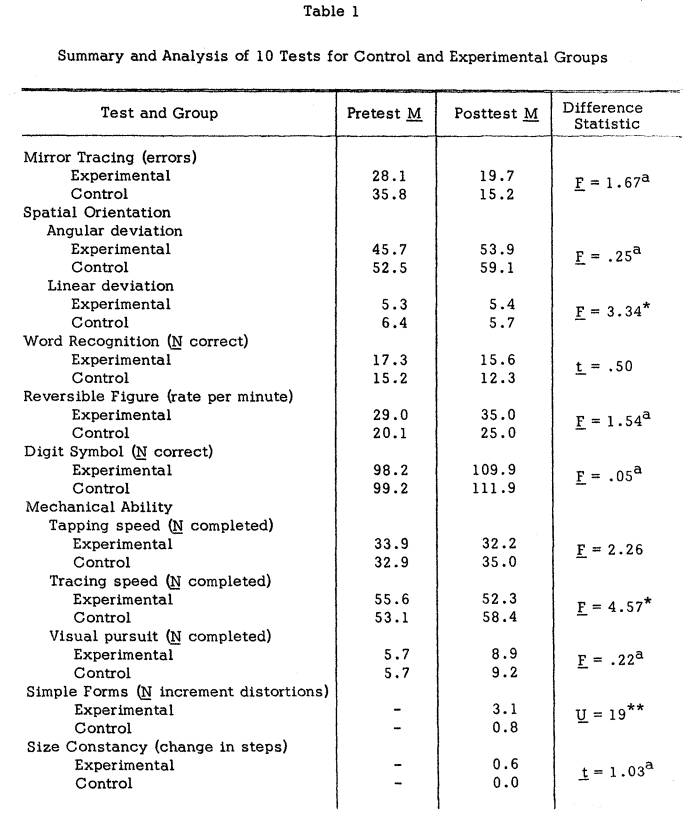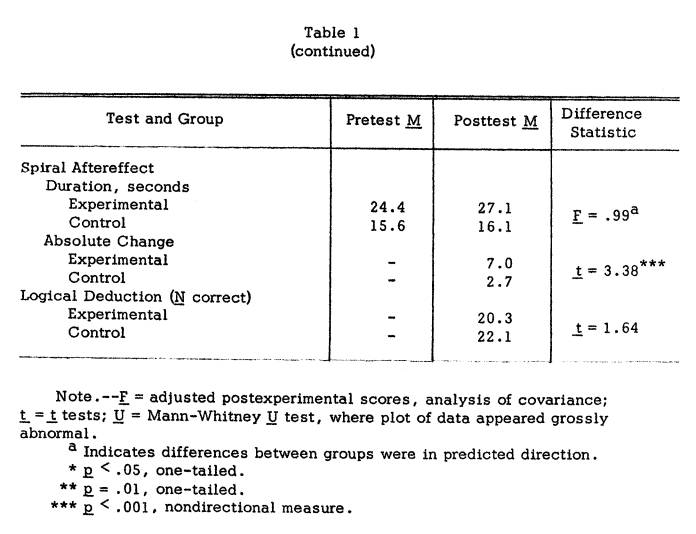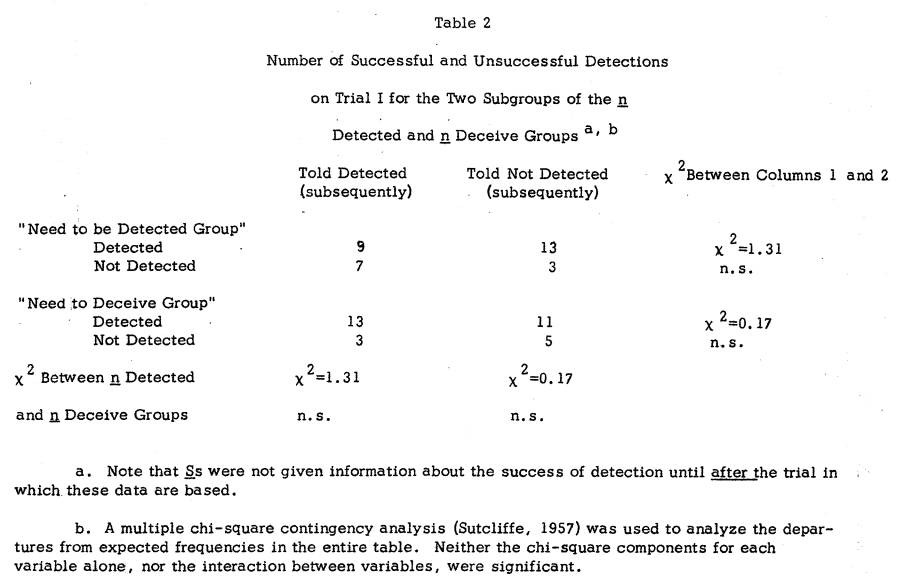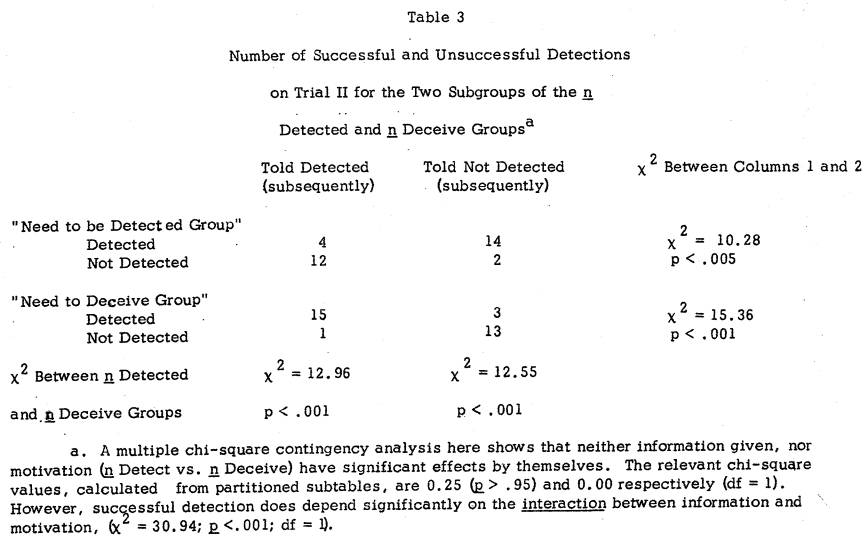
Orne, M. T. O. (1966) Demand characteristics and the set to cooperate. In Symposium 14: Experimental analysis of set. Proceedings of the 18th International Congress of Psychology. Moscow, 1966. Pp. 153-162. (The version below is scanned from the manuscript copy of the published article.)
Institute of the Pennsylvania Hospital and University of Pennsylvania
1. Paper read at International Congress of Psychology, Moscow, August, 1966. In Proc. 18th Int. Conar. Psychol., Symposium 14: Experimental Analysis of Set. Moscow, 1966. Pp. 153-162.
2. The substantive studies on which this paper was based were supported in part by Contract No. DA-49-193-MD-2647 from the United States Army Medical Research and Development Command and in part by Contract No. Nonr-4731 (00) from the Office of Naval Research.
3. I wish to thank my colleagues at the Unit for Experimental Psychiatry for their comments in the preparation of this paper: Ulric Neisser, Julio M. Dittborn, Frederick J. Evans, Donald N. O'Connell, Emily C. Orne, Peter W. Sheehan and Richard I. Thackray.
Page 1
It has long been recognized that an individual's "Einstellung," or set, has significant effects on problem-solving, learning, and a wide range of other behavior. Preparatory sets, sets to learn, and sets for specific responses have been much studied. We will be concerned here with another type of set, which is present and powerful in a wide range of experimental situations but rarely recognized: the set to cooperate, to play an active part in ensuring that the experiment turns out "properly. "
Although Es tend to assume that Ss respond passively to instructions and to experimental stimuli, this assumption does not hold up under scrutiny. In most psychological studies the _S comes to the laboratory having already agreed to participate in an experiment. Whether he is paid or not, he has reasons of his own for coming. The motives which brought him also give him a real stake in the experimental outcome. These motives should not be taken lightly. If it were not for a considerable emotional investment in the experiment, ,as would not willingly endure boredom, discomfort or even intense pain with so little apparent resentment. That is why they distinguish sharply between discomfort which is necessary for the experiment and that which is due to the E's oversight or ineptness. The same S who willingly carries out a monotonous task for many hours will resent being kept waiting needlessly for fifteen minutes prior to the experiment. The S who shows no resentment at the repeated venipunctures necessary to draw several samples of blood will become annoyed if the E_ needs to insert the needle twice in order to find a vein.
2
The Ss' involvement with the experiment also appears in the questions they ask. At the end of a study they often wonder whether they have behaved appropriately, and whether the experiment has been successful. This again suggests a far from passive attitude on their part.
It is not difficult to understand why a student, the typical S of psychological studies, would wish to take part in an experiment. He often hopes to contribute to science and human knowledge by his participation, and may also have an idealistic identification with the E_ and his aims. This implies, however, that he wants his participation to be really helpful. From a student's point of view, he has helped only if the experiment in which he participates is successful, which to him means that it validates the hypothesis of the „Z and at the same time reflects favorably
on himself. In most experiments these two objectives are quite compatible.
The S's set to cooperate means that he views an experiment as a problem-solving situation. He actively interprets all available information in order to find out what behavior would be "appropriate. " He bases his behavior on every cue which might help him discover what the experiment is about, what is expected of him, and what the E hopes to find. I have labelled the sum total of these cues the "demand characteristics" of the experimental situation. They include much more than the explicit verbal instructions which are given to the S. Equally or more important are the rumors . might have heard about the experiment, the laboratory, its personnel, the type of equipment that is used, the actions and attitudes of the f, and especially, the experimental procedure itself.
3
The effectiveness of these cues in creating demand characteristics depends upon their congruence with the other cues in the situation, from the point of view of the S. Thus instructions will not be effective in creating certain demand characteristics unless they fit with what the _S may expect from the total setting and the experimental procedure in the light of his past learning and experience. Often the less explicit cues such as those communicated by the experimental procedure--of which the _S is presumably not aware--will be the more significant determinants of the demand characteristics.
It should be clear that demand characteristics can never be eliminated from psychological studies. It is possible to eliminate instructions, and to treat a human _S as if he were an experimental animal, but this does not prevent him from formulating hypotheses based upon the total setting and the experimental procedure. One may eliminate contact between S and S to control certain types of unintentional bias, but again this does not prevent the S from forming expectations and acting on them.
Demand characteristics are not always of central importance. Under some circumstances, the effect of the experimental stimuli may be great enough to overshadow their effects completely. Under other circumstances the demand characteristics may be powerful, but so ill-defined that they are perceived differently by different $s and their effect is merely to increase error variance. Often, however, the demand characteristics become the major determinant of Ss' behavior. This possibility is always
4
worth taking into consideration, but is especially likely as an explanation of paradoxical results, as when the same procedure yields differing results in different laboratories, or when very different procedures inevitably lead to the same result in the same laboratory. In such cases, it is wise to employ special procedures which can uncover the demand characteristics and reveal their effects. Without such procedures--"quasi-controls," as I have called them--experimental results may be misinterpreted in very serious ways.
To illustrate the power of this apparently subtle variable, I will report two very different studies. Both are taken from fields which, at first glance, might not seem to be subject to these difficulties.
The first study (Orne & Scheibe, 1964) sheds some light on recent work in "sensory deprivation." Although early experiments seemed to show that deprivation has serious consequences, many of these studies had failed to take the possible effects of demand characteristics into account.. Therefore, we designed a condition which would have no trace of real sensory deprivation, but would maintain its usual demand characteristics. We called our condition "meaning deprivation." As dependent variables, we had tests of the kind previously used to measure changes due to sensory deprivation.
One group of 10 Ss was told that they would take part in a "meaning deprivation" experiment. They were carefully screened for physical or emotional disorders, reassured repeatedly that the experiment was safe, and asked to sign the usual S "release form." These are forms which release
5
the E from legal liability for anything that may happen to the S. They are widely used in studies dealing with sensory deprivation. After the necessary pretests, the Ss were taken to a well-lighted cubicle, which contained a comfortable chair, a desk, food and water. An optional task (serial addition) was also provided. The Ss were shown a small red button (the "panic button" of many sensory deprivation studies) and told that if they could not stand the experiment any longer, they need only press the button; a loud bell would ring, and the Ed would immediately release them. If they experienced anything strange, saw anything strange, smelled anything strange, or had any other unusual experiences, they were to report these over a microphone. After this, they were told there was "nothing to worry about, " and locked into the experimental cubicle for four hours. At the end of that time, they were released and given the postexperimental tests.
The Ss of a control group were exposed to very different demand characteristics. There was no screening examination, no release form, and no panic button. The Ss were told that they were controls for a sensory deprivation experiment. However, they were exposed to the identical fourhour experimental treatment. Table 1 shows that significant differences at the . 01 level were found to appear between the two groups, similar to those which had previously been reported as associated with sensory deprivation itself .
Let me emphasize that our study does not show that real sensorydeprivation effects cannot occur. It does show, however, that the demand
6
characteristics usually associated with sensory-deprivation studies would themselves account for many of the effects often reported. In definitive work, demand-characteristic effects must be differentiated from those that may actually be due to sensory deprivation.
In an entirely different context are some psychophysiological experiments. We have been studying the GSR as an indicator of deception: "lie detection," as it is usually called. Previous contradictory findings had been reported concerning an important point. What is the effect of having been detected on subsequent detection attempts? We suspected that the conflicting results stemmed from differences in demand characteristics. To check on this point, we used pre-experimental instructions to vary the demand characteristics for two groups of as (Gustafson & Orne, 1965). One group was led to suppose that being detected was desirable. They were told: "This is a study of lie detection. As you know, a lie detector is a scientific instrument. However, psychopaths and habitual liars are very difficult to detect. In the study we are assessing the adequacy of the technique. We want you to try to fool the lie detector. It is your job to fool the machine. Good luck!" The other group was essentially told that going undetected was desirable: "This is a study in lie detection. Only very stable and emotionally mature individuals are able to fool the lie detector. We want you to try your best to fool the machine. Good luck!" The rest of the experiment was identical for all Ss. They were shown cards with numbers and were asked to select one, apparently without the E's
7
knowledge. A tape-recording was then played on which all the possible numbers were repeated in the form of questions. The -S was instructed to
to reply "No" to each number, so that one of his responses was necessarily a lie. Table 2 illustrates that, on this first trial, the GSRs accompanying the lie were not significantly different in the two groups. After the first trial, regardless of S's actual physiological response, the F entered the room and told half of the Ss what their card had been--thus indicating that they had been detected. To the other half of the Ss, E named the wrong card, so they believed that they had gone undetected.
A second trial was now given to each S, in order to determine the effect of the feedback on subsequent detection. As shown in Table 3, the two groups showed exactly opposite reactions to correct and incorrect detection. In those who had been striving for detection, because "psychopaths are difficult to detect, " the indication that they had been found out apparently was so satisfacotry that their emotional reaction to "lying" disappeared. They became undetectable. The very same indication produced a strong response in those subjects who had hoped to go Undetected, and made them easier to detect on the next trial. It should be emphasized that the physiological criterion for detection was the GSR response; that the experimental treatment, except for the pre-experimental instructions, was identical throughout; and that the effect of the demand characteristics became apparent only in interaction with the experimental treatment.
8
These two examples illustrate a variable which may be important in a wide variety of psychological studies. Demand characteristics give rise to a special kind of set, less often studied than many other kinds, which is often a significant determinant of behavior. Elsewhere, the author has suggested a variety of techniques, the "quasi-controls, " which serve to uncover the demand characteristics of an experimental procedure (Orne, 1959a; 1959b; 1962; 1965). As long as we are dealing with human Ss, it is essential to consider the effect of the powerful motives which bring them to the experiment.
9

10

11

12

13
References
Gustafson, L. A., & Orne, M. T. The effects of perceived role and rolesuccess on the detection of deception. J. appl. Psychol., 1965, 49, 412-417.
Orne, M. T. The demand characteristics of an experimental design and their implications. Paper read at Amer. Psychol. Ass., Cincinnati, September, 1959. (a)
Orne, M. T. The nature of hypnosis: Artifact and essence. . abnorm, soc. Psychol. , 1959, 58, 277-299. (b)
Orne, M. T. On the social psychology of the psychological experiment: With particular reference to demand characteristics and their implications. Amer. Psychologist, 1962, 17, 776-783.
Orne, M. T. Demand characteristics and their implications for real life: The importance of quasi-controls. Paper read at Amer. Psychol. Ass., Chicago, September, 1965.
Orne, M. T. , & Scheibe, K. E. The contribution of nondeprivation factors in the production of sensory deprivation effects: The psychology of the "panic button." J. abnorm. sop. Psychol., 1964, 68, 3-12.
Sutcliffe, J. P. A general method of analysis of frequency data for multiple classification designs. Psychol. Bull. , 1957, 54, 135-137.